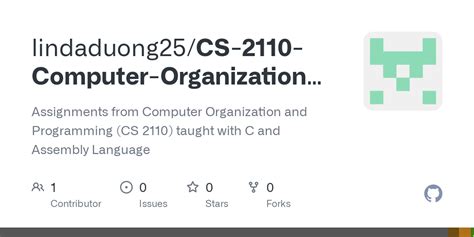Sherly
You need 4 min read
Post on Feb 03, 2025
Table of Contents

Navigating the CS 2110 GitHub Landscape: A Comprehensive Guide
For students enrolled in Cornell University's CS 2110 (or similar introductory computer science courses at other institutions), GitHub becomes an indispensable tool. This guide will help you understand how GitHub is used in CS 2110, providing tips and tricks for effective navigation and collaboration. We'll cover everything from understanding the repository structure to best practices for contributing and managing your code.
Understanding the CS 2110 GitHub Repository
The CS 2110 GitHub repository (or a similar course repository) serves as the central hub for course materials, assignments, and potentially collaborative projects. It's crucial to understand its structure and how to interact with it. Expect to find the following:
- Course Materials: Lecture notes, slides, and potentially supplementary readings might be hosted here. This is a great centralized location to access all the important course information.
- Assignment Specifications: Detailed descriptions of each assignment, including requirements, grading rubrics, and submission instructions, are typically located within the repository.
- Starter Code: Many assignments will provide starter code that gives you a foundation to build upon. Learning how to effectively use and modify this starter code is a critical part of the course.
- Example Code/Solutions: Some repositories might include examples of well-written code or even solutions to past assignments (though be mindful of academic integrity).
- Testing Infrastructure: You'll often find scripts or automated tests designed to help you verify the correctness of your code. Mastering these tests is vital for success.
Navigating the Repository Structure
Most likely, the repository will be organized into folders, each representing a specific assignment or project. Within each assignment folder, you might find:
- README.md: This file contains essential information about the assignment, including goals, instructions, and potentially hints. Always read this file carefully.
- Source Code Files: These are the files containing your code (e.g.,
.java,.c,.cpp). - Test Files: Files containing automated tests for your code.
- Other Supporting Files: There might be additional files such as documentation, images, or configuration settings.
Working with Git and GitHub
This section dives into practical usage and best practices.
Cloning the Repository:
First, you will need to clone the repository to your local machine. This creates a copy of the repository on your computer. You can do this using the git clone command in your terminal. Instructions on how to do this will typically be provided by your instructor.
Making Changes and Committing:
Once you've cloned the repository, make your changes to the code. After making changes, you need to:
- Stage Changes: Use
git add <filename>to stage the files you want to commit. - Commit Changes: Use
git commit -m "Your descriptive commit message"to save your changes locally. A descriptive commit message is essential for tracking your progress and understanding your changes. - Push Changes: Use
git push origin <branch_name>to upload your changes to the remote repository on GitHub. This makes your changes accessible to your instructor or collaborators.
Branching and Merging:
For larger projects, using Git branches is highly recommended. Branches allow you to work on separate features or bug fixes without affecting the main codebase. Learning to create, merge, and manage branches is crucial for effective collaboration.
Pulling Updates:
Before making significant changes, it's crucial to pull the latest changes from the remote repository using git pull origin <branch_name>. This ensures you're working with the most up-to-date version of the code and avoids conflicts.
Collaboration and Teamwork
Many CS 2110 projects involve collaboration. GitHub facilitates teamwork through features like:
- Pull Requests: This is the standard way to contribute changes to a shared repository. Submitting a pull request allows for code review and discussion before merging changes into the main branch.
- Issues: Issues can be used to track bugs, propose feature requests, or ask questions about the assignment.
Troubleshooting Common Issues
Be prepared to encounter issues. Familiarize yourself with common Git commands like git status, git log, and git reset to help you resolve problems. Searching for solutions online and utilizing the course's communication channels (e.g., forums, office hours) is highly encouraged.
Conclusion
Successfully navigating the CS 2110 GitHub environment is a crucial skill for success in the course. By understanding the repository structure, mastering Git commands, and embracing collaborative practices, you can effectively utilize GitHub to learn and excel. Remember to consult the course documentation and utilize available resources for assistance. Good luck!
Thanks for visiting this site! We hope you enjoyed this article.
